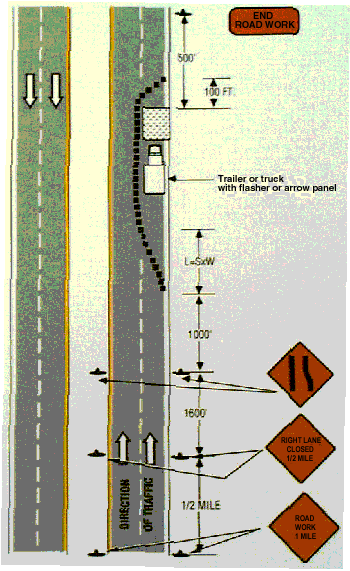U.S. Department of Transportation
Federal Highway Administration
1200 New Jersey Avenue, SE
Washington, DC 20590
202-366-4000
Federal Highway Administration Research and Technology
Coordinating, Developing, and Delivering Highway Transportation Innovations
 |
| This report is an archived publication and may contain dated technical, contact, and link information |
|
Publication Number: FHWA-RD-97-135
Date: January 1998 |
Older Driver Highway Design Handbook
Highway construction and maintenance zones deserve special consideration with respect to older driver needs because of their strong potential to violate driver expectancy. Alexander and Lunenfeld (1986) properly emphasized that driver expectancy is a key factor affecting the safety and efficiency of all aspects of the driving task. Consequently, it is understandable that accident analyses consistently show that more accidents occur on highway segments containing construction zones than on the same highway segments before the zones were implemented (Juergens, 1972; Graham, Paulsen, and Glennon, 1977; Lisle, 1978; Nemeth and Migletz, 1978; Paulsen, Harwood, and Glennon, 1978; Garber and Woo, 1990; Hawkins, Kacir, and Ogden, 1992). Work zone traffic control must provide adequate notice to motorists describing the condition ahead, the location, and the required driver response. Once drivers reach a work zone, pavement markings, signing, and channelization must be conspicuous and unambiguous in providing guidance through the area. The National Transportation Safety Board (NTSB) believes that the MUTCD guidelines concerning signing and other work zone safety features provide more than adequate warning for a vigilant driver, but may be inadequate for an inattentive or otherwise impaired driver (NTSB, 1992). It is within this context that functional deficits associated with normal aging, as described below, may place older drivers at greater risk when negotiating work zones. In an accident analysis at 20 case-study work zone locations, among the most frequently listed contributing factors were driver attention errors and failure to yield the right-of-way (Pigman and Agent, 1990). Older drivers are most likely to demonstrate these deficits. Research on selective attention has documented that older adults respond much more slowly to stimuli that are unexpected (Hoyer and Familant, 1987), suggesting that older adults could be particularly disadvantaged by changes in roadway geometry and operations characteristic of construction zones. There is also research indicating that older adults are more likely to respond to new traffic patterns in an "automatized" fashion, resulting in more frequent driver errors (Fisk, McGee, and Giambra, 1988). To respond in situations that require decisions among multiple and/or unfamiliar alternatives, with unexpected path-following cues, drivers' actions are described by complex reaction times that are longer than reaction times in simple situations with expected cues. In Mihal and Barrett's (1976) analysis relating simple, choice, and complex reaction time to crash involvement, only an increase in complex reaction time was associated with accidents. The relationship with driver age was most striking: the correlation between complex reaction time and accident involvement increased from 0.27 for the total analysis sample (all ages) to 0.52 when only older adults were included. Such data suggest that in situations where there is increased complexity in the information to be processed by drivers—such as work zones—the most relevant information must be communicated in a dramatic manner to ensure that it receives a high priority by older individuals. Compounding their exaggerated difficulties in allocating attention to the most relevant aspects of novel driving situations, diminished visual capabilities among older drivers are well documented (McFarland, Domey, Warren, and Ward, 1960; Weymouth, 1960; Richards, 1972; Pitts, 1982; Sekuler, Kline, and Dismukes, 1982; Owsley, Sekuler, and Siemsen, 1983; Wood and Troutbeck, 1994). Deficits in static and dynamic acuity and contrast sensitivity, particularly under low luminance conditions, make it more difficult for them to detect and read traffic signs, to read variable message signs, and to detect pavement markings and downstream channelization devices. Olson (1988) determined that for a traffic sign to be noticed at night in a visually complex environment, its reflectivity must be increased by a factor of 10 to achieve the same level of conspicuity as in a low-complexity environment. Mace (1988) asserted that the minimum required visibility distance—the distance from a traffic sign required by drivers in order to detect, understand, make a decision, and complete a vehicle maneuver before reaching a sign—is increased significantly for older drivers due to their poorer visual acuity and contrast sensitivity, coupled with inadequate sign luminance and legend size. Other age-related deficits cited by Mace (1988) include lowered driver alertness, slower detection time in complex roadway scenes due to distraction from irrelevant stimuli, increased time to understand unclear messages such as symbols, and slower decisionmaking. This section will provide recommendations to enhance the performance of diminished-capacity drivers as they approach and travel through construction/work zones, keyed to five specific design elements: A. advance signing for lane closure(s); B. variable (changeable) message signing practices; C. channelization practices; D. delineation of crossovers/alternate travel paths; and E. temporary pavement markings. The Handbook recommendations that follow are supported by material presented later in the "Rationale and Supporting Evidence" section under the "Construction/Work Zones" heading. Recommendations by Design ElementA. Design Element: Advance Signing for Lane Closure(s)
The rationale and supporting evidence for this recommendation can be found by clicking here 
B.Design Element: Variable (Changeable) Message Signing Practices
C. Design Element: Channelization Practices
D.Design Element: Delineation of Crossovers/Alternate Travel Paths
E. Design Element: Temporary Pavement Markings
|